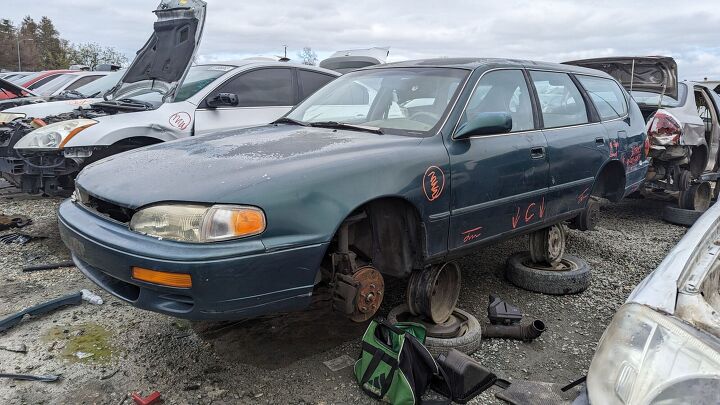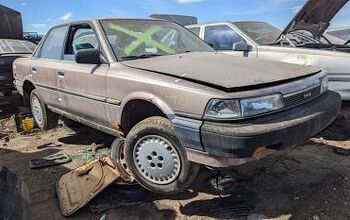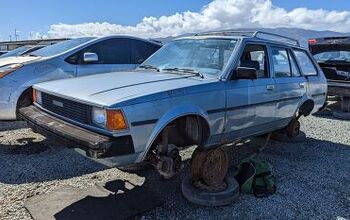Junkyard Find: 1996 Toyota Camry Wagon

Toyota sold new Camry station wagons in North America from the 1987 through 1996 model years. I've found a couple of examples of the first-year longroof Camry during my junkyard travels, but the final-year cars remained elusive… until I spotted this one in a Silicon Valley car graveyard in April.
Car shoppers on our continent had been steadily losing interest in wagons since the year of Peak Wagon (1977), with de-wagon-ification really accelerating when minivan sales took off in the 1980s and the SUV craze took full effect in the 1990s.
By 1996, Toyota showrooms had the RAV4 and the Previa to lure away potential Camry Wagon buyers, with the increasingly macho 4Runner standing by to snare those who didn't mind driving a truck with a jouncy truck ride.
Still, someone was willing to buy this car, and it stayed on the road for 27 years.
As a member of Generation X with a decidedly 1970s childhood, I'm expected to be a fanatical supporter of station wagons. However, my own family had a full-sized Chevy Beauville 3/4-ton van and no wagons during the 1970s and all of my personal wagon-owning experience derives from an assortment of cop-auction-obtained Toyota Tercels and a Subaru Outback that I married into. I don't feel much passion one way or the other for the station wagon.
That said, I think the station wagon makes more sense for most real-world applications than nearly all SUVs and most minivans, and I'm disappointed that we have shunned them so thoroughly.
This car racked up a respectable final mile count, though 226k isn't noteworthy by Camry standards. I've found several used-up Camrys with better than 300,000 miles on their odometers, including an '87 wagon with 322,110 miles.
You could get the 1996 Camry with a 188-horse V6, but this car has the base 2.2-liter four-cylinder and 125 horsepower.
New Camry sedans were still available in the United States with manual transmissions in 1996 (in fact, new manual-equipped Camry sedans could be bought here through the 2011 model year), but the last year for a three-pedal Camry wagon was 1991.
The 1992-1996 Camry wagons got these cool-looking dual rear wipers.
Room for all the accolades.
In Japan, this car was called the Scepter, and it was an American import.
[Images: The Author]
Become a TTAC insider. Get the latest news, features, TTAC takes, and everything else that gets to the truth about cars first by subscribing to our newsletter.

Murilee Martin is the pen name of Phil Greden, a writer who has lived in Minnesota, California, Georgia and (now) Colorado. He has toiled at copywriting, technical writing, junkmail writing, fiction writing and now automotive writing. He has owned many terrible vehicles and some good ones. He spends a great deal of time in self-service junkyards. These days, he writes for publications including Autoweek, Autoblog, Hagerty, The Truth About Cars and Capital One.
More by Murilee Martin
Latest Car Reviews
Read moreLatest Product Reviews
Read moreRecent Comments
- Tassos Under incompetent, affirmative action hire Mary Barra, GM has been shooting itself in the foot on a daily basis.Whether the Malibu cancellation has been one of these shootings is NOT obvious at all.GM should be run as a PROFITABLE BUSINESS and NOT as an outfit that satisfies everybody and his mother in law's pet preferences.IF the Malibu was UNPROFITABLE, it SHOULD be canceled.More generally, if its SEGMENT is Unprofitable, and HALF the makers cancel their midsize sedans, not only will it lead to the SURVIVAL OF THE FITTEST ones, but the survivors will obviously be more profitable if the LOSERS were kept being produced and the SMALL PIE of midsize sedans would yield slim pickings for every participant.SO NO, I APPROVE of the demise of the unprofitable Malibu, and hope Nissan does the same to the Altima, Hyundai with the SOnata, Mazda with the Mazda 6, and as many others as it takes to make the REMAINING players, like the Excellent, sporty Accord and the Bulletproof Reliable, cheap to maintain CAMRY, more profitable and affordable.
- GregLocock Car companies can only really sell cars that people who are new car buyers will pay a profitable price for. As it turns out fewer and fewer new car buyers want sedans. Large sedans can be nice to drive, certainly, but the number of new car buyers (the only ones that matter in this discussion) are prepared to sacrifice steering and handling for more obvious things like passenger and cargo space, or even some attempt at off roading. We know US new car buyers don't really care about handling because they fell for FWD in large cars.
- Slavuta Why is everybody sweating? Like sedans? - go buy one. Better - 2. Let CRV/RAV rust on the dealer lot. I have 3 sedans on the driveway. My neighbor - 2. Neighbors on each of our other side - 8 SUVs.
- Theflyersfan With sedans, especially, I wonder how many of those sales are to rental fleets. With the exception of the Civic and Accord, there are still rows of sedans mixed in with the RAV4s at every airport rental lot. I doubt the breakdown in sales is publicly published, so who knows... GM isn't out of the sedan business - Cadillac exists and I can't believe I'm typing this but they are actually decent - and I think they are making a huge mistake, especially if there's an extended oil price hike (cough...Iran...cough) and people want smaller and hybrids. But if one is only tied to the quarterly shareholder reports and not trends and the big picture, bad decisions like this get made.
- Wjtinfwb Not proud of what Stellantis is rolling out?










































Comments
Join the conversation
The dual rear window wipers on the rear lift gate “quirks and features” were also used on the late 80’s early 90’s Cressida wagon.
In America, when Toyota redesigned the Camry for the 1997 model year, they discontinued the wagon. Honda would also discontinue the Accord Wagon the following year. Wagons are better than SUVs, so it is unfortunate the America doesn't get wagons anymore